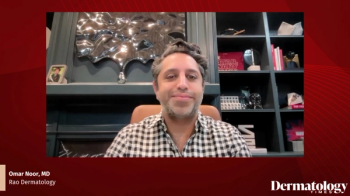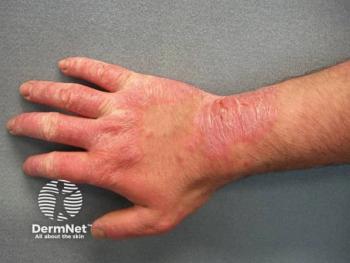
- Dermatology Times, May 2025 (Vol. 46. No. 05)
- Volume 46
- Issue 05
Experts Look Ahead to the Advancements in AD Research
Key Takeaways
- Novel therapeutics targeting the OX40/OX40L pathway and long-acting IL-13 inhibitors show promise for more durable and convenient AD treatment.
- Pediatric AD treatments are expanding, with a focus on microbiome manipulation and botanical therapies, addressing the need for younger age groups.
To hear more about AD advancements from Shahriari and Lio in person, register to attend the Revolutionizing Atopic Dermatitis Conference 2025 in Nashville, Tennessee, on June 6 and 7.
What does meaningful progress in atopic dermatitis (AD) look like in 2025? Is it new therapeutic classes, improved personalized treatment, or greater access to care? With AD research advancing at a pace previously seen in psoriasis, clinicians are increasingly asked to differentiate between drugs, patient profiles, disease severity, and inflammatory pathways.
Beyond approvals, how are these advances reshaping patient care, and where is the specialty headed next? To answer these questions, Mona Shahriari, MD; and Peter Lio, MD, shared the advancements in AD research they are looking forward to most.
Shahriari, assistant clinical professor of dermatology at Yale School of Medicine and associate director of clinical trials at Central CT Dermatology Research in Connecticut, highlighted upcoming therapeutics targeting the OX40/OX40L pathway and the potential for a long-acting IL-13 inhibitor.
Lio, clinical assistant professor of dermatology and pediatrics at Northwestern University Feinberg School of Medicine and founding director of the Chicago Integrative Eczema Center in Illinois, discussed the development of AD treatments for children that have proven effective in adults and a pathway for FDA-approved botanical treatments.
What advancements in atopic dermatitis are you most excited about?
Shahriari: AD is a complex and heterogeneous inflammatory skin disease with a shared foundation of type 2 inflammation across all patients. However, mounting evidence reveals that subsets of individuals also exhibit contributions from Th1 and Th17 pathways, highlighting the diverse immunologic drivers of the disease. This heterogeneity has fueled the push for upstream, T-cell–directed therapies that can modulate inflammation more comprehensively. One of the most promising targets is the OX40/OX40L pathway, which plays a critical role in antigen-specific T-cell activation, proliferation, and survival. By targeting this axis, we may address the root cause of immune dysregulation in AD, offering the potential for not only symptom control, but also for disease modification.
Two OX40-targeting biologics—amlitelimab (anti-OX40L) and rocatinlimab (anti-OX40)—are in phase 3 clinical trials. Both have demonstrated encouraging efficacy and safety in earlier studies and carry the potential to transform AD management. These therapies offer hope for less frequent dosing and even the possibility of off-drug remission, which would mark a dramatic shift in how we approach long-term disease control.
In parallel, innovation continues in the IL-13 space. APG777, a long-acting IL-13 inhibitor, has entered phase 2 trials with an ambitious goal: twice-yearly dosing. This is groundbreaking in a field where most current biologics require biweekly or monthly administration. If successful, APG777 could redefine treatment adherence and convenience and possibly open the door to once-a-year maintenance therapy in the future.
As we await the results of these pivotal trials, the excitement is palpable. The future of AD treatment is shifting toward therapies that are not only more targeted but also more durable, convenient, and potentially capable of long-term remission.
Lio: Something I’m excited to see is the development of AD treatments for children that we already know work in adults and teens. Clinically speaking, the difference between a 12-year-old and a 9-year-old is minimal from an AD perspective, but the need is equally great. I’m hopeful we will see these treatments in the younger age groups soon.
However, developing treatments for AD is a little different in babies. FDA approval seems to take the longest for treatments indicated for children under 2 years of age. In the meantime, we hope to have many more treatments in the 2- to 11-year-old range, which will open many doors. I also believe we’re due for some exciting new approaches. One of the discussions that has come up is having additional ways to approach AD, including working directly on the microbiome. That includes different types of topical probiotics and other ways to manipulate the microbiome, which is truly exciting.
We’re also seeing new directions toward personalized and individualized care to better understand how pediatric AD is different from adult AD. Are there certain approaches that might work better for younger patients? For me, that includes botanicals and natural treatments. There are a couple of companies looking into true botanical options. There’s also an FDA pathway for approving a botanical drug,1 which I’m really excited about. A lot of my families who are nervous about conventional medications might be much more open to a botanical, plant-based treatment, especially one that’s gone through a rigorous set of studies for both safety and efficacy. It may be a bit less rigorous than for a synthetic drug, but if it goes through this pathway, it’s still approved and commercially available with insurance, which could be a game changer for AD.
Reference
- US Department of Health and Human Services; Food and Drug Administration; Center for Drug Evaluation and Research. Botanical drug development: guidance for industry. December 2016. Accessed April 14, 2025.
https://www.fda.gov/files/drugs/published/Botanical-Drug-Development—Guidance-for-Industry.pdf
To hear more about AD advancements from Shahriari and Lio in person,
Articles in this issue
Newsletter
Like what you’re reading? Subscribe to Dermatology Times for weekly updates on therapies, innovations, and real-world practice tips.



















